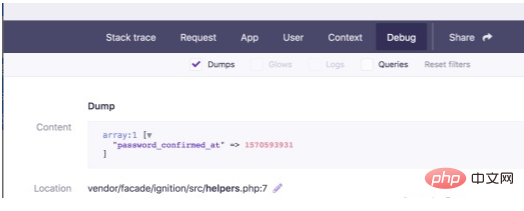 PHP Framework
PHP Framework
 Laravel
Laravel
 New password confirmation process for user login in Laravel 6.2 (code example)
New password confirmation process for user login in Laravel 6.2 (code example)
New password confirmation process for user login in Laravel 6.2 (code example)

Laravel has released v6.2, which adds a new password confirmation feature that allows you to require logged in users to re-enter their password before they can access routes.
This function is similar to the GitHub confirmation dialog box when you perform sensitive operations. You can easily set this up in Laravel, so let's try out the new feature so you can better understand how it works:
SETUP
First, in order to understand this new feature more intuitively, we create a new Laravel application:
laravel new confirm-app cd confirm-app composer require laravel/ui --dev
As you know, the make:auth command was removed in Laravel 6, and the same functionality has been migrated to laravel/ui. In the official expansion package. Let us use a new command to generate user authentication related code:
php artisan ui vue --auth yarn install yarn dev
Next, we configure the SQLite database (of course you can choose the database you want to use):
touch database/database.sqlite
We have created the default configuration file required by Laravel when using the sqlite driver, but you still need to update the .env file to ensure the database connection and path are correct:
DB_CONNECTION=sqlite # ... # 使用 sqlite 驱动程序的默认路径 # DB_DATABASE=laravel
Next, let’s run the migration and then create a test user:
php artisan migrate
We can create it in the console through the factory() method A test user:
php artisan tinker >>> $user = factory(App\User::class)->create([ ... 'password' => bcrypt('secret'), ... 'email' => 'admin@example.com' ... ]);
Write the controller.
Assume you want the user to view administrative actions such as adding an SSH key before Re-verify their password. We want users to re-enter their passwords within a configured window (default is three hours).
We will create a fake /settings/ssh/create route, in which we need the new password.confirm middleware before the user can create a new key:
php artisan make:controller Settings/SSHController
Next, create the method create() in this controller:
namespace App\Http\Controllers\Settings;
use App\Http\Controllers\Controller;
use Illuminate\Http\Request;
class SSHController extends Controller
{
public function create()
{
return view('secret');
}
}
We will stub the secret template and place it at the root of the view path In the directory resources/views/secret.blade.php:
@extends('layouts.app') @section('content') <div class="container"> <div class="row justify-content-center"> <div class="col-md-8"> <h1 id="Add-nbsp-a-nbsp-New-nbsp-SSH-nbsp-Key">Add a New SSH Key</h1> <p>This page is only shown after password confirmation.</p> </div> </div> </div> @endsection
When coding, you should copy the file auth/passwords/confirm.blade.php to your project . You can get the file to copy here: ui/confirm.stub. Copy this file and add it to your project in the following path:
resources/views/auth/passwords/confirm.blade.php
Next, we need to define the routes, in routes/ At the end of the web.php file I mention the need for this middleware:
Route::namespace('Settings')
->middleware(['auth'])
->group(function () {
Route::get('/settings/ssh/create', 'SSHController@create')->middleware('password.confirm');
});
Note: Typically, you can aggregate all routes that require authentication through the auth middleware. In this demo , we created a controller in the Settings namespace.
With it, once you log in, you will be redirected to /home. There, navigate to /settings/ssh/create and you will be prompted for your password:

If you follow this tutorial, enter secret, submit the form, and then enter the create view. Once you confirm your password, you can refresh this page without prompting.
Use the new ddd() helper function, add it to your SSHController::create() method, the method will determine the value of session in auth.password_confirmed_at the next time you are prompted:
public function create()
{
ddd(session('auth'));
return view('secret');
}

This is the last time the password was verified. By default, users will not be reminded to verify their password again within 3 hours. Of course, you can customize it by modifying the config('auth.password_timeout') configuration item (the configuration item is defined in config/auth. of Laravel v6.2.0. php configuration file).
For more technical articles related to the laravel framework, please visit the laravel tutorial column!
The above is the detailed content of New password confirmation process for user login in Laravel 6.2 (code example). For more information, please follow other related articles on the PHP Chinese website!

Hot AI Tools

Undresser.AI Undress
AI-powered app for creating realistic nude photos

AI Clothes Remover
Online AI tool for removing clothes from photos.

Undress AI Tool
Undress images for free

Clothoff.io
AI clothes remover

Video Face Swap
Swap faces in any video effortlessly with our completely free AI face swap tool!

Hot Article

Hot Tools

Notepad++7.3.1
Easy-to-use and free code editor

SublimeText3 Chinese version
Chinese version, very easy to use

Zend Studio 13.0.1
Powerful PHP integrated development environment

Dreamweaver CS6
Visual web development tools

SublimeText3 Mac version
God-level code editing software (SublimeText3)

Hot Topics
 1666
1666
 14
14
 1425
1425
 52
52
 1325
1325
 25
25
 1272
1272
 29
29
 1252
1252
 24
24
 Laravel Introduction Example
Apr 18, 2025 pm 12:45 PM
Laravel Introduction Example
Apr 18, 2025 pm 12:45 PM
Laravel is a PHP framework for easy building of web applications. It provides a range of powerful features including: Installation: Install the Laravel CLI globally with Composer and create applications in the project directory. Routing: Define the relationship between the URL and the handler in routes/web.php. View: Create a view in resources/views to render the application's interface. Database Integration: Provides out-of-the-box integration with databases such as MySQL and uses migration to create and modify tables. Model and Controller: The model represents the database entity and the controller processes HTTP requests.
 Solve caching issues in Craft CMS: Using wiejeben/craft-laravel-mix plug-in
Apr 18, 2025 am 09:24 AM
Solve caching issues in Craft CMS: Using wiejeben/craft-laravel-mix plug-in
Apr 18, 2025 am 09:24 AM
When developing websites using CraftCMS, you often encounter resource file caching problems, especially when you frequently update CSS and JavaScript files, old versions of files may still be cached by the browser, causing users to not see the latest changes in time. This problem not only affects the user experience, but also increases the difficulty of development and debugging. Recently, I encountered similar troubles in my project, and after some exploration, I found the plugin wiejeben/craft-laravel-mix, which perfectly solved my caching problem.
 How to learn Laravel How to learn Laravel for free
Apr 18, 2025 pm 12:51 PM
How to learn Laravel How to learn Laravel for free
Apr 18, 2025 pm 12:51 PM
Want to learn the Laravel framework, but suffer from no resources or economic pressure? This article provides you with free learning of Laravel, teaching you how to use resources such as online platforms, documents and community forums to lay a solid foundation for your PHP development journey from getting started to master.
 Laravel user login function
Apr 18, 2025 pm 12:48 PM
Laravel user login function
Apr 18, 2025 pm 12:48 PM
Laravel provides a comprehensive Auth framework for implementing user login functions, including: Defining user models (Eloquent model), creating login forms (Blade template engine), writing login controllers (inheriting Auth\LoginController), verifying login requests (Auth::attempt) Redirecting after login is successful (redirect) considering security factors: hash passwords, anti-CSRF protection, rate limiting and security headers. In addition, the Auth framework also provides functions such as resetting passwords, registering and verifying emails. For details, please refer to the Laravel documentation: https://laravel.com/doc
 Laravel framework installation method
Apr 18, 2025 pm 12:54 PM
Laravel framework installation method
Apr 18, 2025 pm 12:54 PM
Article summary: This article provides detailed step-by-step instructions to guide readers on how to easily install the Laravel framework. Laravel is a powerful PHP framework that speeds up the development process of web applications. This tutorial covers the installation process from system requirements to configuring databases and setting up routing. By following these steps, readers can quickly and efficiently lay a solid foundation for their Laravel project.
 What versions of laravel are there? How to choose the version of laravel for beginners
Apr 18, 2025 pm 01:03 PM
What versions of laravel are there? How to choose the version of laravel for beginners
Apr 18, 2025 pm 01:03 PM
In the Laravel framework version selection guide for beginners, this article dives into the version differences of Laravel, designed to assist beginners in making informed choices among many versions. We will focus on the key features of each release, compare their pros and cons, and provide useful advice to help beginners choose the most suitable version of Laravel based on their skill level and project requirements. For beginners, choosing a suitable version of Laravel is crucial because it can significantly impact their learning curve and overall development experience.
 How to view the version number of laravel? How to view the version number of laravel
Apr 18, 2025 pm 01:00 PM
How to view the version number of laravel? How to view the version number of laravel
Apr 18, 2025 pm 01:00 PM
The Laravel framework has built-in methods to easily view its version number to meet the different needs of developers. This article will explore these methods, including using the Composer command line tool, accessing .env files, or obtaining version information through PHP code. These methods are essential for maintaining and managing versioning of Laravel applications.
 The difference between laravel and thinkphp
Apr 18, 2025 pm 01:09 PM
The difference between laravel and thinkphp
Apr 18, 2025 pm 01:09 PM
Laravel and ThinkPHP are both popular PHP frameworks and have their own advantages and disadvantages in development. This article will compare the two in depth, highlighting their architecture, features, and performance differences to help developers make informed choices based on their specific project needs.



